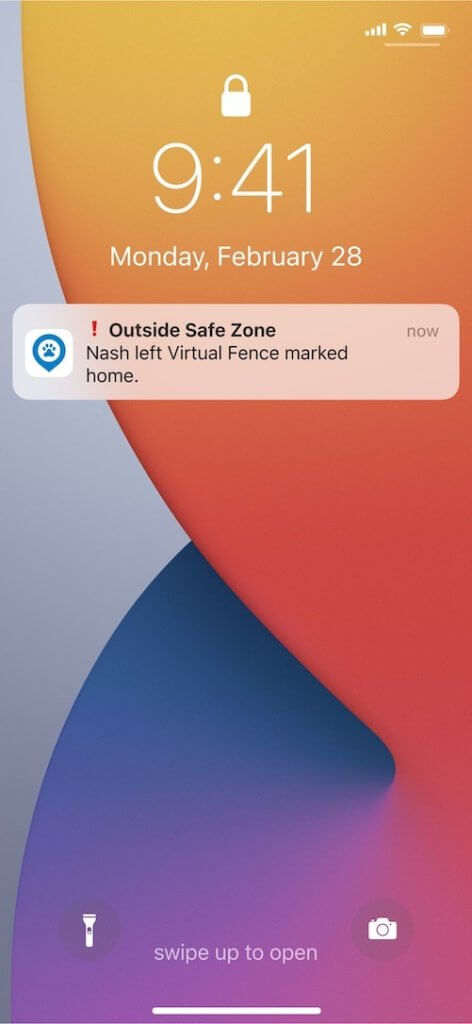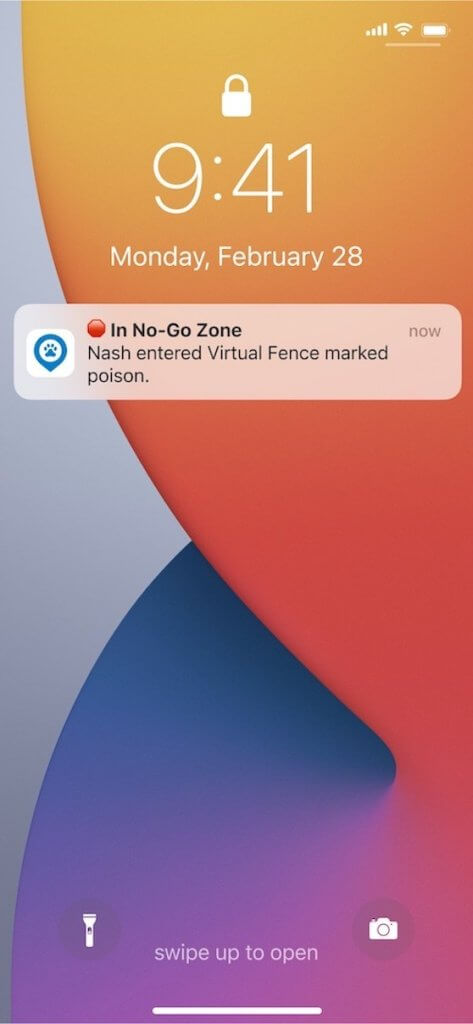Dog Jumping Fence? How To Handle An Escape Artist Dog
It can be downright scary - and sometimes even embarrassing - when your dog keeps jumping the fence. Luckily, here are two surefire ways to prevent your dog from escaping. Aka, tiring them out - and following their every step in real-time.
You’re enjoying a peaceful afternoon in the backyard with your pooch. Then like an Olympic gymnast, your dog takes a running leap and vaults over the fence. As you dash out the gate after your pup, you wonder, Why does this keep happening?! Discover the reasons why and what to do about a dog jumping fence in this post! (Including how to prevent an escape.)
Key Takeaways
Understand why your dog is jumping
Common reasons for this behavior include boredom, loneliness, high energy, separation or noise anxiety, and prey or mating drives.
Address your dog’s behavior with these tweaks
Ensure your dog gets enough daily exercise and mental stimulation. Don’t skip on their obedience training, and spend some quality time with them in the yard.
Modify your fence
Extending the fence height, adding bamboo or wire, installing a redundant fence, or using coyote rollers can all prevent your dog from getting a grip on the top.
Use a Tractive GPS Virtual Fence as a humane alternative
Avoid using electric or invisible fences that might shock and potentially injure your dog. The Tractive GPS Virtual Fence can alert you if your dog leaves a “safe zone” – so you can intervene and bring them back to safety.

Always know your buddy is healthy & safe
Read moreWhy is your dog jumping fence in the first place?
If fence jumping is one of your dog’s favorite sports, you need to address this troublesome issue right away. It could be due to:
- Boredom
If your dog doesn’t have enough to do in your yard, they’ll seek excitement on the other side of the fence. Else, they may get into the trash, dig in the garden, or make other messes. - Loneliness
Don’t leave your dog unattended in the yard. The moment you leave them alone is when escape artists make their move. - Mating drive
Which is a powerful instinct in dogs that are not neutered. Talk to your vet about getting your pup neutered if jumping fences is a recurring problem. - High energy
Some dogs run away simply because they’ve just got so much energy to burn. Tiring out your dog with regular playtime and exercise turns up as a solution. - Separation anxiety
Which may cause your pooch to escape the backyard. (Especially if they see you on the other side of the fence.) - Noise anxiety
Loud noises like fireworks or thunder could startle your dog and cause them to escape. - Prey drive
If your dog has fence jumping tendencies, they will not hesitate to scale the fence to chase potential prey like a squirrel. (Or chase down an intruder, like a raccoon – or even your neighbor’s cat.)
💡A smart dog tracker can help you track your escape artist dog in real-time. Plus, if you invest in a dedicated pet tracker like Tractive, you can even get an escape alert if they try to jump fence or sneak past a “safe zone.”

Follow your dog anywhere
Get real-time location information, wherever they go. And find out when they try to make an escape, or just when they go somewhere they shouldn’t, with Virtual Fences.
8 ways to prevent a dog jumping fence attempt
- Daily exercise
A dog worn out from a good walk or frequent play might be less likely to jump the fence. If you can’t fit in a long walk, get friends, family, neighbors, or a dog walker to help out. - Giving your dog a mental workout
Food puzzles, obstacle course, or a visit to the dog park can keep your dog mentally active and reduce boredom. - Obedience training
A few minutes a day of training the most basic dog commands can really pay off if your dog jumps the fence. A simple “Come!” or recall command can bring your pup right back to your side – you won’t even have to chase them through the neighborhood. - Games (with treats)
Hide treats around the yard and let your dog sniff them out. Add a sandbox or designated digging pit to direct your dog’s digging instincts to a non-destructive activity. A playpen is another idea for containing them during playtime. - Make the yard a pleasing retreat
Create some sheltered areas for your pup to hide from the elements. Also make sure to protect your dog paws in winter and the colder, snowy months. - Hang out with your dog in the backyard
By spending quality time with your dog in the yard, they start to associate it with positive experiences. But if you leave them alone for too long, they’re more likely to get bored and get up to mischief. - Get rid of things that might help your dog climb
Your dog might stand on a picnic table, woodpile, rock, or swing set to enable a leap over the fence. Keep these away to prevent them from a fence jump attempt.
8 tips to improve your fencing
If you’ve tried everything and still, your dog keeps jumping the fence, it may be time to alter the existing fence in some way. Just make sure to check with your Home Owner’s Association to see if there are rules regarding fencing materials in your neighborhood.
1) Extend the fence height
Making your fence taller is an obvious way to make it harder for your dog to escape. Some pet parents attach strips of wooden lattice to an existing wooden fence. This adds another foot or so of height. Adjusting the fence height in this way can be a bit expensive.
2) Bamboo rolls
A cheaper option is to add a layer of bamboo rolls or chicken wire along the top of your existing fence. Be sure to attach the bamboo rolls or chicken wire to sturdy uprights to prevent sagging.
3) Redundant fencing
Let’s say your yard has an existing six-foot-high wooden fence. A redundant fence is installed a few feet inside the main fence. The redundant fence can be three to four feet tall and be made of chain link, bamboo, or wire fencing.
This secondary fence prevents your dog from taking a long-running leap to scale the tall fence. With a redundant fence in place, they have to jump over two fences in succession. So it’s unlikely (but not impossible, of course) that they can scale the fence from a standing position.
⚠️ A redundant dog fence around your entire backyard can be expensive. Consider installing a redundant fence only in the problem area where your dog usually jumps over your existing fence.
4) Coyote rollers
A relatively inexpensive DIY option to prevent your dog from leaping over the fence is to install coyote rollers. Originally created to keep coyotes out of people’s yards, coyote rollers can also keep your dog in the yard.
Dogs often grab the top of the fence on their way over, then heave their body up and out. A coyote roller prevents the dog from getting a grip on the top of the fence. Made from PVC pipe that spins on a wire, coyote rollers are an inexpensive solution that could be an option for keeping your dog in the backyard.
5) Install a peek-a-boo window in your fence
If you have a solid wood existing fence and your dog jumps out to see what’s on the other side, add a peek-a-boo window in the fence.
- Cut a 12-inch square hole at dog-nose height.
- Insert a 12-inch square sheet of acrylic into the hole, and frame it in securely.
- Now your pup can view what’s happening on the other side of the fence. (And hopefully won’t be lured over the top.)
6) Install slats to block the view
If your dog is constantly tempted to chase after squirrels or other dogs that they can see through your chain link fence, install slats to restrict the dog’s view. They’ll be less distracted and will focus more on all the fun activities available inside your backyard.
Read more: 15 Outdoor Dog Fence Ideas.
7) Avoid invisible, wireless, or electric fences
Invisible dog fences don’t need a physical setup. Rather, you can keep an open yard – and if your dog tries to leave the fence boundary, they get a small electric shock. Which, over time, is meant to train them to stay within boundaries and prevent wandering. Underground dog fences work similarly, administering a static shock to your dog if they try and leave the boundary.
⚠️ Which is why vets, animal rights groups, and even Tractive all advise strongly against using electric dog fences or e-collars for dogs.
- They can cause both physical and psychological harm to them – and in general, negative reinforcement or punishment don’t work.
- Your dog is more likely to respond aggressively out of self-defence – barking, whining, or even biting.
- The repeated experience of shocks from an invisible dog fence may even encourage them to run away.
8) Consider a Virtual Fence instead
Rather, here’s a smart, humane alternative that’ll neither burn a hole in your wallet – nor will it compromise your dog’s love and trust in you. A virtual fence. Here’s how the Tractive GPS Virtual Fence might work instead.
In under 5 minutes, you can draw a “safe zone” around your home or backyard. This tells your Tractive device to monitor your dog as long as they stay within these boundaries. But the minute your dog jumps fence or tries to escape…


By taking an active role in your dog’s safety, you’re helping build a longer, happier future together. (One fence jump at a time.)



